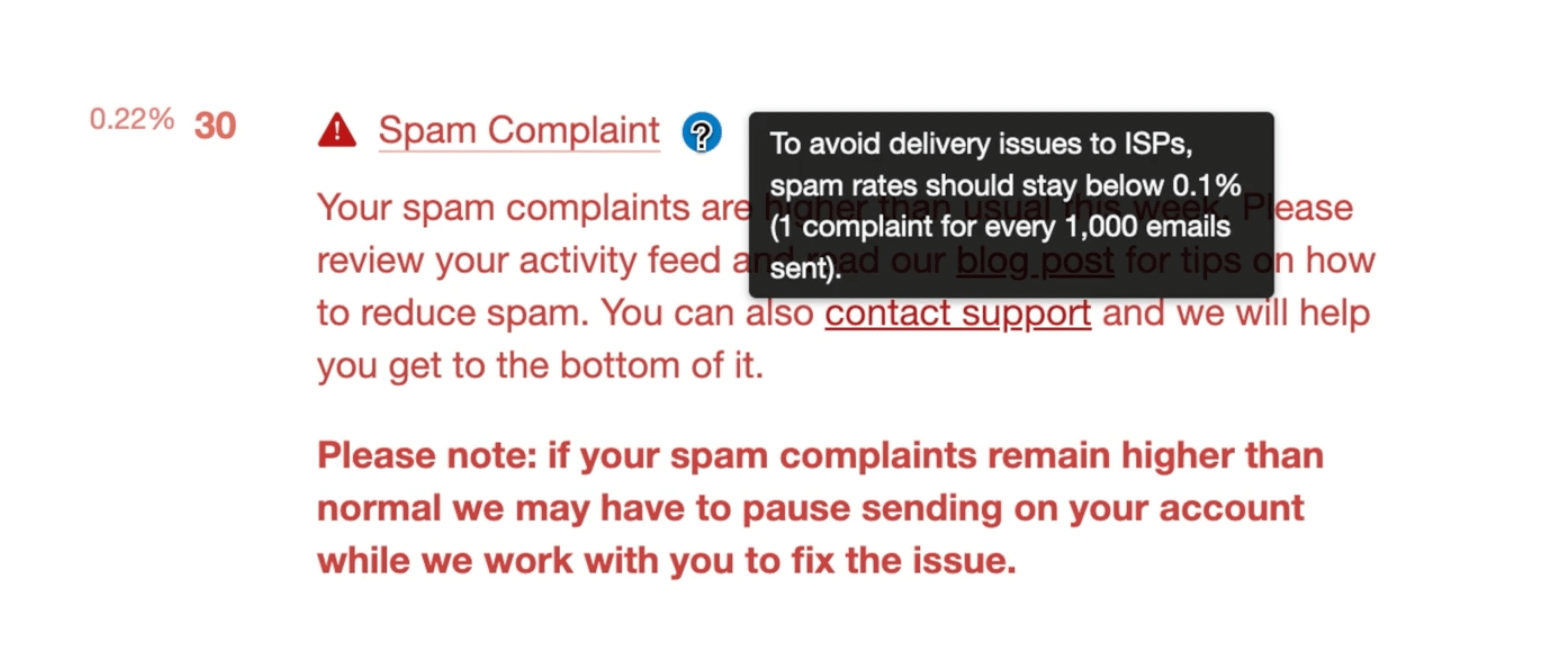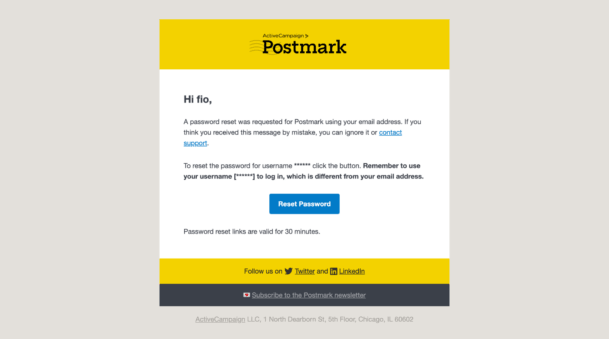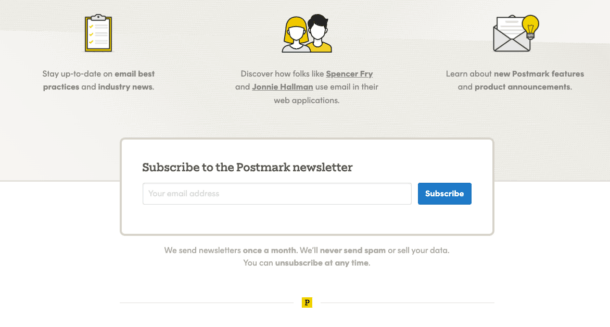Why recipients marked your email as spam, and how to fix it
We’ve been running Postmark for more than ten years, and protecting our customers and IP reputations from spammers has always been one of our missions.
Many have commented that our spam threshold at Postmark is low compared to other providers. We allow up to 10 complaints for every 10,000 sent emails, or 0.10%. That’s right, 1/10th of a percent.

Why is it so low? Because we strongly believe that true, honest emailing should generate ~0 spam complaints. Before you dismiss the boldness of our statement and shout, “That’s unattainable!”, let us explain our stance.
Your transactional emails should never go to spam
#
A transactional email is a system-generated email in response to some action: a sign-up, a comment notification, an invoice, etc. Because the message is tied to a user action, transactional emails should be delivered with 100% expectation from the user about to receive them, and further, provide action or value for the recipient.
Spam complaints are usually generated when a recipient is NOT expecting an email, so by our definition a well-designed transactional email should generate no complaints.
To get there, review your app and transactional email templates to make sure:
Your application is very clear that it will send the user an email when they take a certain action, for example (We’ve sent you an email confirmation email, etc).
The email has consistent branding with your app: this ensures your users know at all times why they received a message and what they should do with it.
Your message’s “From” name, “From” address, and subject line are very relevant to your brand and the action the user just took. For example, if you are sending out a password reset email, your subject line should be simple and straightforward, e.g. [BRAND] password reset.

Pro tip: in Postmark, your transactional message would be delivered within a few seconds. This helps ensure your user remembers and knows what the message is about. Make sure your ESP has great delivery times—you can check out ours, which are publicly available on our status page.
Case study: 0% spam complaints at DMARC Digests #
We've had this belief that good transactional emails should have 0% spam complaints since the very beginning of Postmark, over a decade ago, and we keep testing it with our own products. For example, at Dmarc Digests, our DMARC monitoring application, we send over 200,000 emails a month, and in our preliminary tests, we generated a total of 0 spam complaints! How cool is that?

Many of our customers who do transactional emails well are seeing the exact same results as us, also validating our theory! Their names are anonymized because we are serious about privacy, but the numbers speak for themselves:



Bonus: if you want more tips and a quick walkthrough focused specifically on transactional emails, my colleague Jordan has just what you need.
The grey area between transactional and marketing emails #
While on the surface the concept of transactional email seems clear—one-to-one, automated email triggered by a user action or event, that the recipient expects to receive—it turns out there are some gray areas. There are other types of emails that would be considered transactional that still catch recipients by surprise, for example:
Invitation emails
Send-to-friend emails
Forum posts
Support responses
Comment/reaction notifications
The first two are not surprising: if you allow someone to invite their entire address book (to an event, a webinar, a meeting, etc.), chances are many of these contacts won't be expecting an email.
Limit the number of referral entries your customers can send to avoid sending spam (or better yet, make the person hand-type each contact they want to invite to keep your spam complaints low).
People often subscribe to a support or a community forum not realizing how many post notifications they’ll receive. When they see the flood, they get annoyed and start marking messages as spam. The worst case is when someone does Select + All + Click Spam. Say hello to 100 complaints at once, and serious damage to your sender's reputation!
We recommend making sure that comment notifications are an option email preference. Also, be sure to provide a clear link to email settings AND a 1-click unsubscribe link somewhere prominent at the bottom of the message. For example, we use Basecamp at work and with every notification we get, we can reply to a comment directly via email but also have the option to unsubscribe or change our settings:

Marketing emails can generate more spam complaints (but they don’t have to): #
A broadcast email (also known as marketing, promotional, commercial, or bulk) is an email that is sent to a list of contacts, with the same content, and is not triggered by a user action. A marketing email would be anything your customer did not specifically trigger: for example, a weekly newsletter, a promotional offer, or an announcement about your site's recent updates.
We’ve seen this type of messaging generate more spam complaints than transactional emails, but it still all comes down to the same reason: your recipients’ expectations.
Here are some things we recommend doing to make sure this doesn’t happen to you.
1. Get their permission to send #
Getting explicit permission to send your recipients a message is one of the most important things you can do as a sender, so we're putting this first. It's the number one key to maintaining a healthy sending reputation and relationship with your recipients.
• Have a clear opt-in/subscribe process
Be upfront with your customers about the fact that they’ll receive broadcast emails, but also specify what type: for example, if they opt-in to receive industry/product newsletter, then you shouldn’t send them sales offers (there should be another opt-in item). Here is our newsletter subscription page: notice how we’re clear on what will be sent, how often, and how people can unsubscribe if they decide to.
• Don't send to old sign-ups
Permission to send can go stale quite quickly and you shouldn't be sending to recipients who you haven't been in touch with recently. As a rule of thumb, we recommend to never send to existing recipients who you haven't been in touch with within the last 3 months or more (although in some specific use cases it makes sense to break this rule—for example, if you’re promoting a yearly event that people subscribed to get updates to before it happens).
• No purchased lists
It should go without saying, but let us be very clear: not only does sending to purchased lists, free lists, or "inherited" lists go against Postmark's Terms of Service if you are our customer, but more in general the GDPR (General Data Protection Regulation) and other privacy laws think it's a pretty big no-no, too.
2. Work on your message content #
Subject lines are your message's first impression. Don't let it be a limp handshake. Ish. Use this opportunity to hook your recipients with a bit of mystique and excitement while helping them understand where the message is coming from.
And while you’re at it, dear {first_name}: personalize your messages!
When you can, simple personalization in the opening of your message or subject line can make a world of difference, and it helps illustrate the point that the message is being tailored to the recipient.

If you can’t/won’t dynamically insert the name of the recipient into your email subject line or body, you can still opt for an informal approach that makes the recipient feel like you’re talking to them. For example, we open most of our newsletter with the word ‘friend’—because that’s how we think of our customers:
3. Make the unsubscribe experience very smooth #
Making it easy for your recipients to unsubscribe from your Broadcast sending is a must. While you may be focusing on doing everything possible to keep your recipients on your mailing list, preventing a recipient from easily unsubscribing can definitely lead to them becoming frustrated and increasing the chances of spam complaints. Two tips:
• Keep your one-click unsubscribe links visible
• Don’t send unsubscribe confirmation emails. Have you ever unsubscribed from a mailing list only to receive a new email from the sender letting you know that you've been successfully unsubscribed? How confusing and unnecessary!
User errors, and what you can do about them #
Depending on the email client the recipient is using and their level of email tech-savviness, some users might mark a message as spam by mistake when they’re tidying their inbox, if the delete and spam buttons are close to each other in the UI (we’re looking at you, Gmail).

These cases are unfortunate and when they happen they’d cause a spam score even less than 0.1% (depending on your sending volume).
Another case that would cause instant multiple complaints is when the above happens AND the user has a 3rd party tool/plugin that would go to all your messages in their inbox and mark them as spam too. While there is no reversing this 😞 what you can do is either, keep an eye, and see your spam rate normalize again as you send more emails (so no need to take any action here) or you see that it happens again, you can, in this case, reach out to the user outside Postmark and ask them to watch out.
The takeaway #
We’ve always believed that good transactional and broadcast email should not generate complaints, as happens with most of our large and small volume senders. We’ve found that when complaints become a problem, there are almost always very clear reasons that a transactional email is causing them, and we work hard to provide tools and share best practices to help our customers improve their deliverability.
One thing stays constant in all our testing: Expectation is key. Making sure that you are super clear on what will happen when that “subscribe” check box gets marked goes a long way. We also recommend staying away from opt-out email preferences. Let people opt-in so they know exactly what is going on, and your reputation will stay clear!




